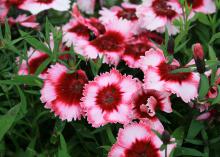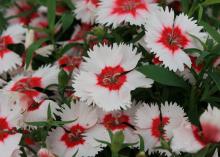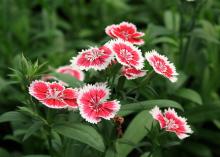Information Possibly Outdated
The information presented on this page was originally released on November 5, 2018. It may not be outdated, but please search our site for more current information. If you plan to quote or reference this information in a publication, please check with the Extension specialist or author before proceeding.
Cool-season dianthus lasts through spring
I love the annual color we can grow all winter in most of our Mississippi gardens and landscapes, so I’m going to spend a few weeks concentrating on cool-season color. Dianthus is my first choice for fall color.
In my coastal Ocean Springs landscape, the dianthus I’m planting now will carry through until spring for an outstanding color display. Planting in the fall allows for a robust root system to develop through the winter, and it results in a beautiful and colorful display next spring.
We all know there will be days and nights with freezing temperatures. During these colder periods, any open flowers will be damaged. Depending on how low the temperature gets, even the foliage will start to turn purplish. I like to think of it as the leaves shivering a bit.
In the southern half of the state, the plants recover from these brief freezing bouts to bloom again. In northern Mississippi, you must provide some protection from cold weather for fall dianthus plantings, or you may simply replant next spring.
I adore the Telstar series of dianthus. Their great colors range from carmine rose, pink and purple to one that is almost red. There are a couple of pretty bicolors that are called picottees.
Telstar is the perfect choice for mass planting in the landscape. These are uniform growing, have a sturdy habit and get only about 10 inches tall and wide.
Another good choice is the Super Parfait series. Super Parfait dianthuses are indeed super, and they are cold weather tolerant, as well. This group is known for its compact size and large blossoms that reach 2 to 2 1/2 inches in diameter.
But don’t think you’re out of luck if you can’t find these named series. This weekend, I bought some really nice-looking generic dianthuses at the garden center.
Dianthus has a uniform growing habit that makes it a perfect mass planting choice. For best performance, always plant in full sun in well-drained soil. Dianthus is susceptible to root disease problems and doesn’t like wet feet. This is a concern in Mississippi’s cool, wet falls and winters.
Dianthus is also a great choice for colorful combination containers. Try pairing with pansies and violas for a great cool-season container. Cool Wave pansies have an improved, trailing growth habit that makes them fantastic spiller plants for containers.
All dianthuses are moderate to heavy feeders. At planting, place about a tablespoon of a good, slow-release fertilizer in the planting hole, and then supplement monthly with a water-soluble fertilizer. To encourage more lateral growth and more flowers, pinch or prune back the plants a couple of inches after the first flush of flowers.
Many people I talk to are surprised that dianthus flowers are edible, just like pansies and violas. Gather the flowers, gently wash them and pat dry. Softly pull on the petals to separate them from the base. Add the petals to any fresh lettuce or fruit salad.
Be careful when selecting plants for edible flowers from the nurseries and garden centers, as you don’t know how they have been treated during the production phase. But you can easily grow dianthus from seed. This way you can grow exactly the varieties and colors you want.





